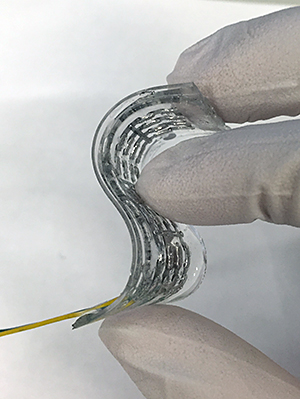
In a proof-of-concept study, North Carolina State University engineers have designed a flexible thermoelectric energy harvester that has the potential to rival the effectiveness of existing power wearable electronic devices using body heat as the only source of energy.
Wearable devices used to monitor a variety of health and environmental measures are becoming increasingly popular. The performance and efficiency of flexible devices, however, pale in comparison to rigid devices, which have been superior in their ability to convert body heat into usable energy.

“We wanted to design a flexible thermoelectric harvester that does not compromise on the material quality of rigid devices yet provides similar or better efficiency,” said Mehmet Ozturk, a professor of electrical and computer engineering at NC State and corresponding author of a paper describing the work. “Using rigid devices is not the best option when you consider a number of different factors.” Ozturk mentioned superior contact resistance – or skin contact – with flexible devices, as well as the ergonomic and comfort considerations to the device wearer.
Ozturk said that he and colleagues Michael Dickey and Daryoosh Vashaee wanted to utilize the best thermoelectric materials used in rigid devices in a flexible package, so that manufacturers wouldn’t need to develop new materials when creating flexible devices.
Ozturk said one of the key challenges of a flexible harvester is to connect thermoelectric elements in series using reliable, low-resistivity interconnects. “We use a liquid metal of gallium and indium – a common, non-toxic alloy called EGaIn – to connect the thermoelectric ‘legs,’” Ozturk said. “The electric resistance of these connections is very low, which is critical since the generated power is inversely proportional to the resistance: Low resistance means more power.
“Using liquid metal also adds a self-healing function: If a connection is broken, the liquid metal will reconnect to make the device work efficiently again. Rigid devices are not able to heal themselves,” Ozturk added.
Ozturk said future work will focus on improving the efficiencies of these flexible devices, by using materials and techniques to further eliminate parasitic resistances.
Learn more: New Design Improves Performance of Flexible Wearable Electronics
The Latest on: Energy harvesting
[google_news title=”” keyword=”energy harvesting” num_posts=”10″ blurb_length=”0″ show_thumb=”left”]- Practical Wireless Energy Transmission Made Possible with INFRGY's Energy Harvesting Circuiton May 2, 2024 at 4:34 am
Device converts high RF signals to DC while augmenting output by harvesting energy from the environment HONOLULU, May 2, 2024 /PRNewswire/ -- INFRGY LLC proudly announces its device to convert high ...
- Exploiting disorder to harvest heat energy: The potentialities of 2D magnets for thermoelectric applicationson April 30, 2024 at 9:20 am
Thermoelectric systems are a green and sustainable way to harvest energy from any form of heat that otherwise would be wasted. At the core of this energy conversion process is the so-called Seebeck ...
- Hurricanes to be turned into power plants: new renewable energy discoveredon April 29, 2024 at 6:30 am
A new type of energy has been discovered: that´s how we will turn hurricans into power plants to get a renewable source in our country ...
- What’s that?…A fuel cell that harvests energy from…dirt?on April 26, 2024 at 7:10 am
A soil microbial fuel cell where microbes in dirt could power applications which are literally “in the field”.
- This salt battery harvests osmotic energy where the river meets the seaon April 24, 2024 at 10:55 am
Estuaries -- where freshwater rivers meet the salty sea -- are great locations for birdwatching and kayaking. In these areas, waters containing different salt concentrations mix and may be sources of ...
- Energy Harvesting System Market Poised for Remarkable Growth, Projected to Reach USD 1317.56 Million by 2031on April 24, 2024 at 9:48 am
The Energy Harvesting System Market demonstrated a robust valuation of USD 638.86 million in 2023. It is projected to experience substantial growth, reaching USD 1317.56 million by 2031. This growth ...
- Revolutionizing Renewable Energy: Innovative Salt Battery Efficiently Harvests Osmotic Poweron April 24, 2024 at 5:00 am
A new semipermeable membrane doubles the osmotic energy output in estuaries, showing potential for sustainable power generation. Estuaries — where freshwater rivers meet the salty sea — are great ...
- Silicon Labs unveils wireless SoCs for energy harvestingon April 23, 2024 at 7:40 am
Silicon Labs introduces its first and most energy-efficient wireless SoCs for developing energy-harvesting devices.
- Silicon Labs’ latest wireless SoCs come with energy harvesting-ready capabilitieson April 23, 2024 at 2:48 am
Silicon Labs has announced the launch of the xG22E family of Wireless SoCs, the company’s first-ever family of devices that have been designed to operate within the ultra-low power envelope required ...
- Silicon Labs Streamlines Energy Harvesting Product Development for Battery-Free IoTon April 22, 2024 at 5:02 am
Silicon Labs (NASDAQ: SLAB), a leader in secure, intelligent wireless technology for a more connected world, today announced their new xG22E family of Wireless SoCs, Silicon Labs' first-ever family ...
via Google News and Bing News










